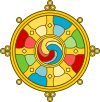Setenling Gompa
Setenling Gompa, Ser Gompa, (pinyin: Saigesi) is a Jonangpa (or Jonang) monastery about a kilometre from the eastern edge of Aba or Ngawa City (Chinese: 阿坝镇; pinyin: Ābà Zhèn Standard Tibetan: Ngawa), the main city in Ngawa (Aba) County, within the Ngawa (Aba) Tibetan and Qiang Autonomous Prefecture (Tibetan: Amdo) in northwestern Sichuan, China. It is located on the Tibetan plateau at an elevation of 3,200 metres (10,499 ft.). The head lama, Thubten Dorje Rinpoche, is still living in the monastery.[1]
| Setenling Gompa | |
|---|---|
| Religion | |
| Affiliation | Tibetan Buddhism |
| Sect | Jonangpa |
| Leadership | Thubten Dorje Rinpoche |
| Location | |
| Location | Aba Tibetan and Qiang Autonomous Prefecture, Sichuan Province of China. |
| Country | China |
 Location within Aba Tibetan and Qiang Autonomous Prefecture | |
| Geographic coordinates | 32°54′1″N 101°43′19.53″E |
| Architecture | |
| Founder | Namnang Dorje |
| Date established | mid-13th to 14th centuries |
| Part of a series on |
| Tibetan Buddhism |
|---|
 |
|
|
|
Practices and attainment |
|
Institutional roles |
|
History and overview |
Description
One enters the courtyard through a gate between the office cum shop of the monastery and a mani wall with the large restored Assembly Hall in front. The Assembly Hall contains many images of Kunkhyen Dolpopa, Jetsun Kunga Drolchok,[2] Taranatha, Namnang Dorje as well as of the deities Cakrasamvara and Kalacakra.
Left of the Assembly Hall are the Tsenyi Dratsang with a walled garden for debating, the Gonkhang with an image of Takkiraja, the 'tiger-riding' form of Mahakala, and the Drubkhang or meditation hermitage with images of Dolpopa, Taranatha, Namnang Dorje and the deity Vajrakila. Newer buildings include the Dukhor Lolang with a three-dimensional mandala of Kalacakra and the Head Lama's residence with a Jokhang Chapel containing many fine images, books and tankas.[3]
History
The monastery was founded by Namnang Dorje, and reconstituted in the late 19th century by Dro-ge Yonten Gyatso. There are about 800 affiliated monks.
Ceremonies
- Sunning the Buddha and turning Maitreya Buddha.
Footnotes
- Kotan publishing (2000), pp. 227-228.
- Stearns, Cyrus (August 2008). "Kunga Drolchok". The Treasury of Lives: Biographies of Himalayan Religious Masters. Retrieved 2013-08-10.
- Dorje (2009), pp. 780-781.
References
- Dorje, Gyurme (2009). Footprint Tibet Handbook. Footprint Books. ISBN 978-1-906098-32-2.
- Kotan Publishing (2000). Mapping the Tibetan World. Kotan Publishing, 2004 reprint. ISBN 0-9701716-0-9.